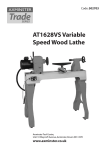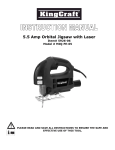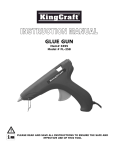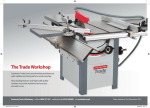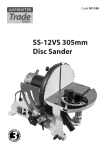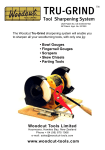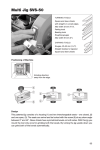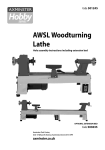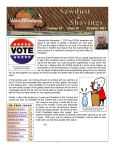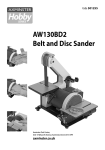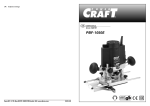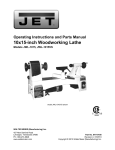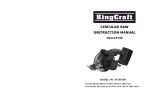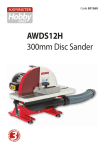Download Axminster AW1416VS Specifications
Transcript
Code: 501214 AT1416VS Woodturning Lathe The AW1416VS utilises the very reliable inverter technology usually found on much larger machines Electronic variable speed is a desirable feature for woodturners, enabling fine tuning of speed to suit larger diameters or out of balance work pieces. Axminster Tool Centre, Unit 10 Weycroft Avenue, Axminster, Devon EX13 5PH www.axminster.co.uk Index of Contents Index of Contents 02 Declaration of Conformity 02 What’s in the Box 03 Optional Accessories 04 General Instructions for 230V Machines 04-05 Specific Safety Instructions for Woodturning Lathes 05 Specifications05 Assembly Instructions 06-07 Illustration and Description 08-09 Indexing Operation 10 Removing Drive/Live Centres 11 Changing the Belt Speed 12 Maintenance13 Parts Breakdown 14-15 Parts Lists 1-2-3 16-17-18 AW1416VS Lathe Stand (Optional) 19 Wiring Diagram 20 Declaration of Conformity Copied from CE Certificate Manufactured by The Kingcraft Machinery Company Limited is in compliance with the following standards or standardisation documents in accordance with Council Directives The undersigned, authorised by Calvin Chou The Kingcraft Machinery Company Limited No. 26 Chung Gong Yeh 12 rd, Da-Li City, Taichung County, Taiwan declares that this product: Machinery Directive: 2006/42/EC Low Voltage Directive: 2006/95EC Electromagnetic Compatibility Directive: 2004/108/EC Woodturning Lathes 1643INV, 1417, 1643, 1417INV, 1430, 1430INV, 1443, 1443INV, 1643INV machine safely and to maintain its efficiency and prolong its life. Keep this Instruction Manual readily accessible for any others who may also be required to use the machine. Please read the Instruction Manual prior to using your new machine; as well as the operating procedures for your new machine, there are numerous hints and tips to help you to use the Warning Fully read manual and safety instructions before use Ear protection should be worn The symbols below advise that you follow the correct safety procedures when using this machine. Eye protection should be worn 2 Dust mask should be worn HAZARD Motor gets hot What’s Included Quantity Item 1 No AT1416VS Woodturning Lathe ( Headstock and Tailstock fitted) 1 No Tool Rest Arm (Fitted to Lathe Bed) 1 No 152mm Tool Rest (Fitted to Tool rest Arm) 1 No 80mm Faceplate (Fitted to Headstock) A 1 No 4 Prong Drive Centre (Fitted to Headstock) B 1 No Live Centre (Fitted to Tailstock) Model Number 1417INV Packet Containing 1 No 1 No 2 No 1 No 2 No 1 No 1 No Push Rod 8mm Hex Key Steel Carryng Handles with four 1/4 unc x 5/8" Phillips Screws 24 Index Pin with Magnetic Base Steel Hooks & (4) Phillips Screws Instruction Manual Guarantee Card C D E F G Having unpacked your new AT1416VS woodturning lathe please dispose of the unwanted packaging responsibly. The cardboard packaging is biodegradable E G C D F A 3 B Optional Accessories Quantity Item 1 No 2 No Extension Bed (Product code: 951249) 5/16” x 1” Caphead Bolts & Spring/washer H I H I General Instructions for 230V Machines that you have unimpeded access to all parts of the machine. The machine is designed for indoor use, do not use when or where it is liable to get wet. Keep the machine clean; it will enable you to more easily see any damage that may have occurred. Good Working Practices/Safety The following suggestions will enable you to observe good working practices, keep yourself and fellow workers safe and maintain your tools and equipment in good working order. Clean the overall machine with a damp soapy cloth if needs be, do not use any solvents or cleaners, as these may cause damage to any plastic parts or to the electrical components. Clean the machine components with a lightly oiled cloth. If the machine is liable to be standing idle for any length of time a light coat of machine or spray oil will minimise rusting. WARNING! KEEP TOOLS AND EQUIPMENT OUT OF THE REACH OF YOUNG CHILDREN Primary Precautions These machines are supplied with a moulded 13 Amp. Plug and 3 core power cable. Before using the machine inspect the cable and the plug to make sure that neither are damaged. If any damage is visible, have the tool inspected/repaired by a suitably qualified person. If it is necessary to replace the plug, it is preferable to use an ‘unbreakable’ type that will resist damage. Only use a 13 Amp plug, and make sure the cable clamp is tightened securely. Fuse as required. If extension leads are to be used, carry out the same safety checks on them, and ensure that they are correctly rated to safely supply the current that is required for your machine. Keep the work area as uncluttered as is practical, this includes personnel as well as material. Under no circumstances should CHILDREN be allowed in work areas. It is good practice to leave the machine unplugged until work is about to commence, also make sure to unplug the machine when it is not in use, or unattended. Always disconnect by pulling on the plug body and not the cable. Once you are ready to commence work, remove all tools used in the setting operations (if any) and place safely out of the way. Re-connect the machine. Carry out a final “tightness” check e.g. chuck or face plate, work piece, tool rest, etc., check that the correct speed has been selected. Work Place/Environment Make sure when the machine is placed that it sits firmly on the bench or stand, that it does not rock, that it is sufficiently clear of adjacent obstacles so 4 General Instructions for 230V Machines Make sure you are comfortable before you start work, balanced, not reaching etc. likewise, consideration should be given to the removal of rings and wristwatches, if these are liable to be a ‘snag’ hazard. Consideration should also be given to non-slip footwear, etc. If the work you are carrying out is liable to generate flying grit, dust or chips, wear the appropriate safety clothing, goggles, gloves, masks etc. If the work operation appears to be excessively noisy, wear ear-defenders. If you wear your hair in a long style, wearing a cap, safety helmet, hairnet, even a sweatband, will minimise the possibility of your hair being caught up in the rotating parts of the tool, DO NOT work with cutting tools of any description if you are tired, your attention is wandering or you are being subjected to distraction. A deep cut, a lost fingertip or worse; is not worth it! Above all, OBSERVE…. make sure you know what is happening around you, and USE YOUR COMMON SENSE. Specific Safety Instructions for Woodturning Lathes 1. Do not use ‘split’ work pieces. must ensure that the mounting accessories (chucks, faceplates etc.,) can be ‘locked’ onto the lathe mandrel, and in the case of chucks have some form of security device to prevent them ‘unwinding’ during reverse operation. 2. Always start at the lowest speed when starting a new task. 3. Check that the tool rest is at or slightly below the centre line of the workpiece. 8. Make sure your tools are stored/racked away from the turning area of the lathe. Do not reach over a rotating work piece at any time. 4. Check the work piece is securely mounted in the lathe before switching on the power. 9. Do not ‘dig in’ or try to take too large a cut. 5. Rotate the work piece by hand, to check that it is centralised, clear of the tool rest, not ‘split’ or has loose knots. 10. Do not leave the lathe running unattended; or leave the machine until everything is stopped. 6. Where lathes have the facility to be reversed; check the machine is rotating in the correct direction. 11. Some turning tools may have specific sharpening angles that have been determined by the manufacturers; when re-sharpening, adhere to these angles to maximise the finish of your work. 7. If your lathe has the facility to run in reverse, you Specification Product Code 501214 ModelAT1416VS RatingTrade Power 230V 50Hz 560W Speed 0-800, 200-1,750, 400-3,600rpm Spindle Taper 2MT Spindle Thread M33 x 3.5mm (Ref T38) Taper Tailstock 2MT Distance Between Centres 400mm Max Diameter over Bed 350mm Tool Rest Stem Diameter 25.4mm Overall L x W x H 865 x 330 x 415mm (With Extension Bed: 1,465 x 330 x 415mm) Weight41kg 5 Assembly Instructions Please take some time to read the section entitled “Illustration & Parts Description” to identify the various parts of your machine so that you are familiar with the terminology we will use to enable you to set up and operate your table lathe safely and correctly. Figure 02 The machine and its accessories will arrive coated with corrosion preventative grease. This will need to be cleaned from the machine, its components and accessories prior to it being set up and commissioned. Use coal oil, paraffin or a proprietary de greaser to remove the barrier grease. Be warned, it will stain if you splash it on clothing etc., wear overalls, coverall et al., rubber gloves are also a good idea, as is eye protection if your cleaning process tends to be a little bit enthusiastic. After cleaning, lightly coat the machine with a thin layer of light machine oil. N.B If you used paraffin/kerosene make sure you apply this thin film sooner rather than later. Pre-drilled holes in lathe bed casting Figure 03 95% of the machine comes fully assembled, (See what’s included) to assemble the remaining 5% please follow the instructions below. Assembling the Carrying handles Locate the two steel carrying handles (E) and the four 1/4 unc x 5/8" Phillips screws, attach them to each end of the lathe bed (See figure 1). Figure 01 Steel hook Figure 04 E Assembling the Power Cable Hooks Steel hooks in position Locate the two steel hooks & Phillips screws (G) and screw them with the hooks facing inwards, into the pre-drilled holes in the lathe bed. (See figures 2-3-4) 6 Assembly Instructions Attaching the Optional Extension Bed (951249) Figure 05 Figure 07 Step 1: Remove the carrying handle from the end of lathe bed and place safely aside I Figure 06 Figure 08 H Step 2: Line-up the pre-drilled holes in the extension bed (H) with the holes in the lathe Step 3: Locate the two 5/16 unc x 1” caphead bolts and spring/washers (I), Slot them through the holes in the extension bed (H) & lightly screw them into the lathe bed, using a Hex key. Clamp the tailstock over the two beds and adjust until both beds are aligned then tighten the bolts, (DO NOT OVERTIGHTEN). (See figures 7-8) Replace the carrying handle (E) and screws to the end of the extension bed (H). AT1416VS Lathe Extension Bed 7 Illustration and Description Tailstock barrel lock Drive centre Access panel Access panel lock Live centre Tailstock lock Power cable hooks Lathe bed Motor Headstock wheel Electronic inverter control unit Headstock Faceplate Tailstock wheel Tool rest Tool rest lock Carrying handle Banjo lock Motor handle Banjo Lift and shift clamping handle Green (ON) Spindle speed LED 8 Red (OFF) Forward/Reverse switch Speed control knob Illustration and Description Electronic Inverter Control Unit General Purpose AC Micro Drive from “Delta Electronics”. The VFD-S drive is famous for its low noise carrier frequency feature and easy to use keypad. The digital keypad comes in two parts; the display panel and keypad. The display provides the parameter display and shows operation status of the AC drive. The keypad provides programming interface between the user and the AC drive. For more information see manufacturer’s manual. Note: The inverter comes preset from the factory and you should not need to make any adjustments. 9 Indexing Operation The indexing facility is useful for fluted columns, clock faces and accurate hole positioning. The indexing pulley has 24 positions (15°) indexing using the supplied index pin (F). Figure 09 1-24 index positions Figure 10 Open the access panel, turn the headstock wheel until the pre-drilled hole in the headstock lines up with one of the 24 pre-drilled hole positions on the index pulley. (See figs 9-10-11) Figure 11 Figure 12 Pre-drilled hole F Locate the 24 index pin (F) and slide the pin into the pre-drilled holes to lock the pulley to the desired position Figure 13 Figure 14 The picture above shows the index The picture above shows the index number is set to position 01 number is set to position 23 Note: The index pin (F) has a magnetic base, enabling the pin to be attached to the lathe to prevent it from being lost. 10 Removing Drive/Live Centres To remove the Drive Centre (A), locate the push rod (C), while holding the tool insert the push rod (C) through the centre hole of the headstock wheel and push the drive centre out. (See figs 15-16-17) Repeat the procedure for the Live Centre in the tailstock. (See fig 18) Figure 15 Figure 16 C Insert the push rod (C) through the headstock and push the drive centre out Centre hole in the headstock operating wheel Figure 17 Figure 18 A Removing the drive centre Live centre in tailstock Changing the Belt Speed Note. The lowest speed pulley combination is furthest from the faceplate, i.e. smallest motor pulley diameter to largest spindle pulley diameter. DISCONNECT THE LATHE FROM THE MAINS SUPPLY! Lower the access panel (A) on the headstock by loosening the access panel lock caphead screw (B), using a Hex key. (See figs 19 & 20) Open the motor access door (C), by pulling the spindle speed LED box towards you. (See fig 21) Loosen the motor’s lift & shift handle, see fig 23, lift the motor plate handle to give enough slack in the belt to enable it to be moved to the new selection. When the belt is located, turn the spindle to ensure the belt is correctly seated. Check that the belt is vertical, the belt must not be run out of vertical alignment, this can cause the belt to ‘jump’ the pulley grooves, possibly the wrong way, and if it does manage to run, it will scuff the sides of the belt badly). When you are sure all is correct, press down on the motor plate handle to put tension on the belt. Note: The belt does not need to be bar taut to operate correctly. 11 Continues Over... Changing the Belt Speed Tighten the lift and shift handle to hold the motor plate in position. Replace the access panel (A) and tighten the caphead screw (B) and close the motor access door (C). Figure 21 C Reconnect the machine to the mains supply. Give the lathe a little ‘burst’ to check it all runs smoothly. When you are satisfied, remove any tools you may have been using; stow carefully away, the lathe is now ready to be used again. Figure 19 B Open the motor access door (C), by pulling the spindle speed LED box towards you. Figure 22 A Loosen the access panel caphead screw (B) using a Hex key. Figure 20 With the motor access door open, gives access to the motor pulley. Figure 23 Lower the access panel to give access to the spindle pulley Loosen the motor’s lift and shift handle and lift the motor plate handle to give enough slack in the belt to enable it to be moved. 12 Maintenance Daily after use Monthly •Clean wood shavings away from the lathe bed and tool rest. •Check the tension of the belt and adjust, (See pages 11 & 12 for Changing the Belt Speed). •Smear a light coat of wax (Protec Tool Wax Polish, Order no. 211835 ) over the lathe bed to allow the Banjo and Tailstock to run more smoothly over the bed and to prevent corrosion. •Check any build up of wood shaving on the motor and spindle pulley’s and clean if necessarily. • Using an airline, blow out the motor’s air vent. Note: If the lathe is not going to be used for a period of time, smear a light coat of wax over the bed and place a dust sheet (product code. 600410), over the lathe. Wax Points 13 Parts Breakdown 14 Parts Breakdown 15 Parts List 1 16 Parts List 2 17 Parts List 3 18 AW1416VS Lathe Stand (Optional) AW1416VS Lathe Stand (Product Code: 951248) 1 LEG BASE 1 2 LEG SUPPORT 1 3 LEG BAR 4 HEX SCREW 1 1.4" - 1/2" 12 5 WASHER 1/4" 12 6 CAP SCREW 3/8"- 1" 4 3/8" 7 WASHER 8 WHEEL 4 2 9 FOOT 3/8" 2 10 NUT 3/8" 2 11 NYLON NUT 5/16" 2 12 WASHER 5/16" 2 13 HEX SCREW 5/16"- 65MM 2 19 Wiring Diagram 20




















